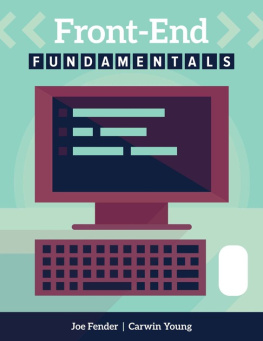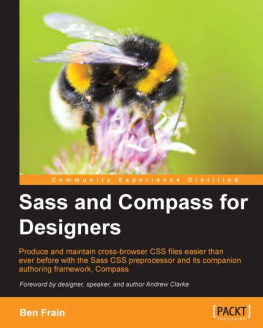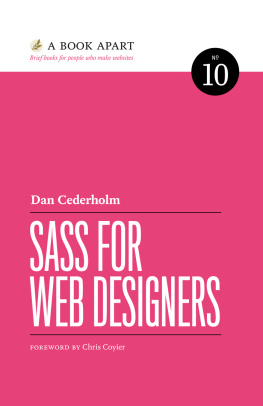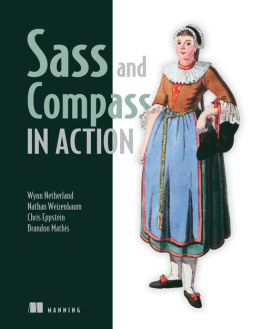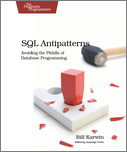Pragmatic Guide to Sass
by Hampton Catlin, Michael Lintorn Catlin
Version: P1.0 (December 2011)
Copyright 2011 The Pragmatic Programmers, LLC. This book is licensed tothe individual who purchased it. We don't copy-protect itbecause that would limit your ability to use it for yourown purposes. Please don't break this trust-don't allow othersto use your copy of the book. Thanks.
- Dave & Andy.
Table of Contents
Copyright 2011, The Pragmatic Bookshelf.
What Readers Are Saying About Pragmatic Guide to Sass
Pragmatic Guide to Sass is a snappy little book that effectively hits you with the right dose of Sass magic to either pick up Sass as a newcomer or give you a refresher if youre already using it. The guide is written in a style thats both a tutorial and a reference at the same time, and itll be a handy go-to book for anyone working with Sass, whether on a daily basis or only on rare occasions. It gets two thumbs-up from me.
| Peter Cooper, editor of Ruby Inside and HTML5 Weekly |
Sass is the best way to write maintainable CSS. This Pragmatic guide will get you up to speed on Sasss most powerful features, including nesting, variables, and mixinsan invaluable reference.
| Sam Stephenson, creator of Sprockets and the Rails asset pipeline |
Michael and Hampton, in Pragmatic Guide to Sass, have put together the most comprehensive and thought-out guide to Sass to date. No matter what server-side technology you use, Sass can be used in anyones development stack to help organize your CSS. Pragmatic Guide to Sass shows you the best practices in DRYing up your CSS with the power of Sass. It teaches you how to become a CSS heavyweight without the bloated CSS. This book should be on every web developers shelf (and e-reader).
| Andrew Chalkley, technical writer, Screencasts.org |
Chock-full of unexpected goodies such as extras on Compass and Haml, Pragmatic Guide to Sass is hands-down the best Sass resource printed to datea must-read for web developers and smart designers.
| Dan Kissell, Codenicely.com |
Acknowledgments
Wed both like to thank the entire team at Pragmatic, who are a great bunch of people to work with. They made the process of writing really enjoyable. In particular, our editor, Kay Keppler, and managing editor, Susannah Pfalzer, were personable and always on hand to answer our most inane questions.
Wed also like to thank our tech reviewers: Peter Cooper, Eric Redmond, Shawn Allison, Jeff Patzer, Trevor Burnham, Bruce Williams, Aaron Godin, and Ian Dees. Your insights were extremely useful.
Hampton: Most importantly, Id like to thank Nathan Weizenbaum, whose endless hours of coding and bug fixes and extensions make Sass what it is today. And I cant forget Chris Eppstein, whose creation of Compass truly changed the Sass landscape forever.
Michael: Thanks to my parents, Alan and Jayne, for not giving me too much grief over stopping my PhD. Final thanks go to the GMO for keeping us sane.
Copyright 2011, The Pragmatic Bookshelf.
Welcome!
Welcome to the Pragmatic Guide to Sass . Sass (Syntactically Awesome Style Sheets) enables you to do amazing things with your style sheets, helping you describe how HTML is laid out on a web page. Sass is an alternative way of writing CSS.
Whats wrong with regular ol CSS? we hear you cry. The fact is that CSS, with all its power and elegance, is missing some crucial, simple elements that other types of development take for granted. CSS can also be a bit complicated to read: Sass fixes that.
Most programmers are familiar with the concept of DRY D ont R epeat Y ourself. It saves time and effort when writing code. A core philosophy of Sass is to reduce repetition in style sheets, and well be coming back to DRY a few times throughout the guide.
Sass isnt really a replacement for CSSits a way to help us write better CSS files, which is essential for large projects. Sass helps us write clear, semantic style sheets. Sass updates CSS development for the future.
Hampton originally designed Sass while he was working at Unspace in Toronto, and Nathan Weizenbaum and Chris Eppstein now maintain it. A lot of Sass functionality depends on Ruby. (But dont worry, well learn how to install Ruby in Part 1, .)
In this book, well be using the word Sass as an overarching concept that describes the engine we use to convert our files into CSS. We can use two syntaxes to write SassSCSS and Original Sass. These will be described a bit later in this preface.
Who Is This Book For?
This book is for people who know the pain of working on the CSS of a mature websitewho have faced a CSS file that four people wrote and that mutated into a huge, sprawling, incoherent mess. Weve looked the beast in the eye and barely survived.
Youre probably already familiar with CSS, HTML, and the ideals of semantic web development. We can all agree that markup should be about logic instead of about presentation (as much as possible). And well assume that youre familiar with margins, padding, the box model, @media queries, and the myriad of other CSS-related technologies.
If you are looking for a CSS-ninja power-up, youve come to the right place.
Nomenclature and Syntax
Some of the terms associated with CSS can be quite confusing, so weve added a short introduction to how we name things in the book. Also, there are two different syntaxes for writing Sass that need to be distinguished.
A Brief CSS Recap
We thought it would be useful to go through a couple of technical terms well be using for different aspects of CSS markup. If youre already familiar with selectors, declaration blocks, and the like, you can probably skip this part.
Lets use a small bit of CSS as an example:
p { |
color: #336699; |
font-size: 2em; |
} |
Here we have p, which we call the selector . What follows (the bit inside the curly braces) is the declaration block . The two linesone defining the color and one defining the font sizeare known as declarations . Each declaration has a property and a value . The property in this case is the color or the font size. The value is the color itselffor example, #336699, blueor the size of the fontfor example, 20px.
The use of classes and IDs allows us to define sets of declarations that will only be applied to specific sections of our HTML. Sass allows you to create much richer selectors, as well see in Part 1, .
SCSS: A More CSS-like Way to Write Sass
SCSS, which stands for S assy CSS, is one of the syntaxes we use to write Sass. The grand aim of SCSS is to keep the look of CSS while introducing the units of Sass. If youre familiar with CSS, its pretty easy to read. We still use selectors, classes, and IDs. We open a curly brace to start the declaration block, and we separate out declarations with semicolons. Whats extra is the added functionality.
When we use the word Sass , well mostly be referring to the SCSS syntax.
Original Sass: A Stripped-down Way to Write Sass
Before SCSS, there was Original Sass, which strips out some of the unnecessary elements of CSS and SCSS. Original Sass can be compiled just the same as SCSS, via the Sass engine.

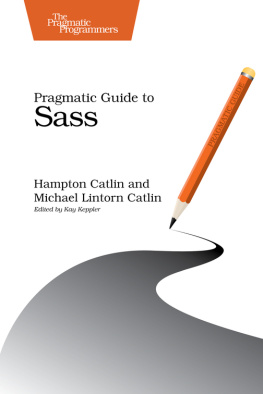


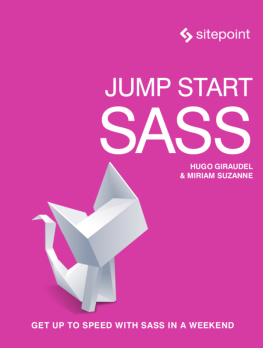
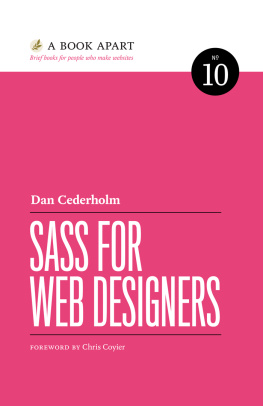
![Anirudh Prabhu [Anirudh Prabhu] - Beginning CSS Preprocessors: With SASS, Compass.js and Less.js](/uploads/posts/book/119148/thumbs/anirudh-prabhu-anirudh-prabhu-beginning-css.jpg)

